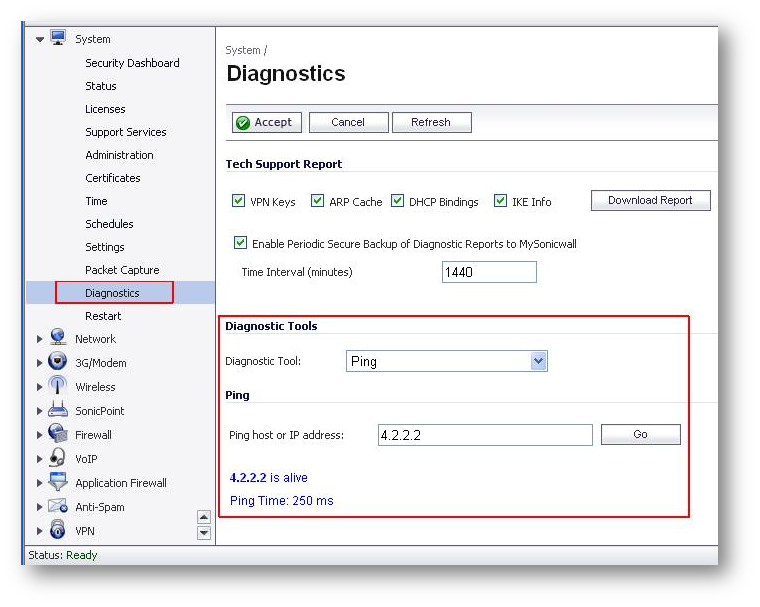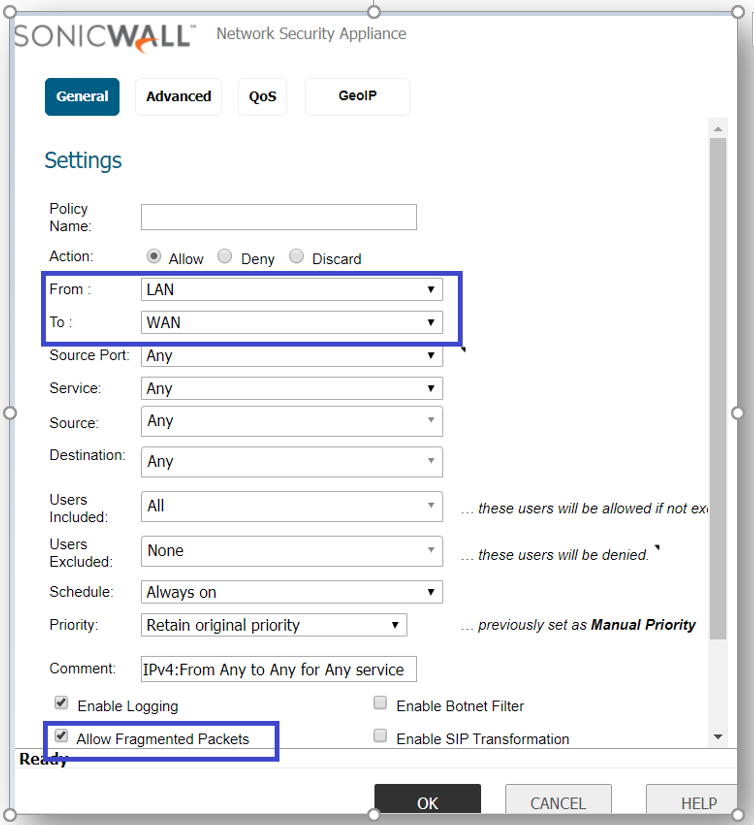Troubleshooting Guide for Computers Unable to Access Internet From Behind the SonicWall
Description
Troubleshooting Guide for Computers Unable to Access Internet From Behind the SonicWall
Resolution for SonicOS 7.X
This release includes significant user interface changes and many new features that are different from the SonicOS 6.5 and earlier firmware. The below resolution is for customers using SonicOS 7.X firmware.
Resolution or Workaround:
- On the SonicWall, Navigate to Device|Diagnostics|Ping. Choose Ping in the “Diagnostic utility” drop down in the Sonic OS Standard and Enhanced firmware. (In 6.x firmware Click Tools > Diagnostics).

2.Ping your ISP’s Default Gateway or any IP that is pingable on the Internet (e.g. 4.2.2.2).
3.If the Ping is alive, check the Default Gateway for the computers in the LAN.
 NOTE: The default Gateway must be the SonicWall LAN IP address.
NOTE: The default Gateway must be the SonicWall LAN IP address.
4.Click Policy> Rules and Policies>Access Rules , disable any “Deny” rules from LAN to WAN. (6.x firmware Click Access > Rules).

5.Check the DNS settings on the client PCs to make sure they can resolve domain names on the Internet.
6.Check your browser settings to make sure the proxy is turned off (if you do not have a proxy in your LAN).
7.Make sure you don't have any open applications like VPN Client etc. Disable any Software Firewall or the Windows Firewall.
8.Try different WAN Link Speed for example 10 Mbps-full duplex ,100 Mbps full duplex etc. The WAN Port speed can be changed by clicking Network | system|Interfaces next to the WAN interface - click Advanced and change the Link speed in the drop down.( in the 6.x firmware navigate to Advanced |Ethernet - Check the force option in the WAN Link settings.

9.Navigate to Policy|Rules and Policies|Access Rules, edit the default LAN to * or LAN to WAN rule and check Allow Fragmented Packet (In the 6.x Firmware Access > Rules).


10.In SonicOS Enhanced, make sure the default NAT policy is in place and enabled

11. If you are still unable to go online, connect a computer directly to the ISP modem / router and make sure you are able to go online. If not, please call your Internet service provider for further assistance.
Resolution for SonicOS 6.5
This release includes significant user interface changes and many new features that are different from the SonicOS 6.2 and earlier firmware. The below resolution is for customers using SonicOS 6.5 firmware.
Resolution or Workaround:
- On the SonicWall, Navigate to System |Diagnostics. Choose Ping in the “Diagnostic utility” drop down in the Sonic OS Standard and Enhanced firmware. (In 6.x firmware Click Tools > Diagnostics).

2.Ping your ISP’s Default Gateway or any IP that is pingable on the Internet (e.g. 4.2.2.2).
3. If the Ping is alive, check the Default Gateway for the computers in the LAN.
NOTE: The default Gateway must be the SonicWall LAN IP address.
4.Click Manage>Rules > Access Rules, disable any “Deny” rules from LAN to WAN. (6.x firmware Click Access > Rules).

5.Check the DNS settings on the client PCs to make sure they can resolve domain names on the Internet.
6.Check your browser settings to make sure the proxy is turned off (if you do not have a proxy in your LAN).
7.Make sure you don't have any open applications like VPN Client etc. Disable any Software Firewall or the Windows Firewall.
8.Try different WAN Link Speed for example 10 Mbps-full duplex ,100 Mbps full duplex etc. The WAN Port speed can be changed by clicking Network | Interface|configure next to the WAN interface - click Advanced and change the Link speed in the drop down.( in the 6.x firmware navigate to Advanced |Ethernet - Check the force option in the WAN Link settings.

9.Navigate to Firewall Manage|Rules| Access rules, edit the default LAN to * or LAN to WAN rule and check Allow Fragmented Packet (In the 6.x Firmware Access > Rules).

10. In SonicOS Enhanced, make sure the default NAT policy is in place and enabled

11. If you are still unable to go online, connect a computer directly to the ISP modem / router and make sure you are able to go online. If not, please call your Internet service provider for further assistance.
Resolution for SonicOS 6.2 and Below
The below resolution is for customers using SonicOS 6.2 and earlier firmware. For firewalls that are generation 6 and newer we suggest to upgrade to the latest general release of SonicOS 6.5 firmware.
Resolution or Workaround:
- On the SonicWall, Navigate to System |Diagnostics. Choose Ping in the “Diagnostic utility” drop down in the Sonic OS Standard and Enhanced firmware. (In 6.x firmware Click Tools > Diagnostics).

- Ping your ISP’s Default Gateway or any IP that is pingable on the Internet (e.g. 4.2.2.2).
- If the Ping is alive, check the Default Gateway for the computers in the LAN.
 NOTE: The default Gateway must be the SonicWall LAN IP address.
NOTE: The default Gateway must be the SonicWall LAN IP address. - Click Firewall > Access Rules, disable any “Deny” rules from LAN to WAN. (6.x firmware Click Access > Rules).

- Check the DNS settings on the client PCs to make sure they can resolve domain names on the Internet.
- Check your browser settings to make sure the proxy is turned off (if you do not have a proxy in your LAN).
- Make sure you don't have any open applications like VPN Client etc. Disable any Software Firewall or the Windows Firewall.
- Try different WAN Link Speed for example 10 Mbps-full duplex ,100 Mbps full duplex etc. The WAN Port speed can be changed by clicking Network | configure next to the WAN interface - click Advanced and change the Link speed in the drop down.( in the 6.x firmware navigate to Advanced |Ethernet - Check the force option in the WAN Link settings.

- Navigate to Firewall | Access rules, edit the default LAN to * or LAN to WAN rule and check Allow Fragmented Packet (In the 6.x Firmware Access > Rules).

- In SonicOS Enhanced, make sure the default NAT policy is in place and enabled

- If you are still unable to go online, connect a computer directly to the ISP modem / router and make sure you are able to go online. If not, please call your Internet service provider for further assistance.
See Also
UTM: Troubleshooting PPPoE ISP Connectivity Issues